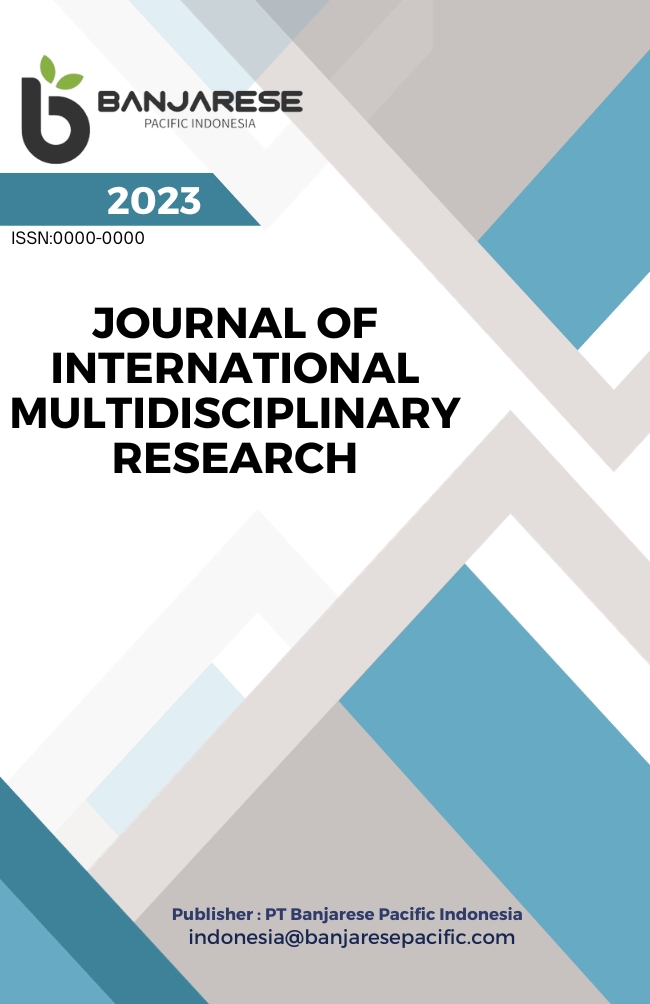Shibotik: Inovasi Kreatif Teknik Pewarnaan Kain Batik (Studi Kasus Industri Kerajinan Batik Komar)
DOI:
https://doi.org/10.62504/992n2d54Keywords:
Dyeing Innovation, Shibotik, Batik KomarAbstract
This research aims to explore innovation in batik coloring techniques through the collaboration of conventional wax and stamp methods with Shibori resist dyeing, known as Shibotik. Conducted at Batik Komar, the qualitative approach employed involved participant observation and in-depth interviews. Over a five-month period, the researcher actively engaged in activities at the batik house, observing production processes, interacting with craftsmen, and creating works using Shibotik coloring techniques. The findings reveal that Batik Komar successfully developed Shibotik as an innovative form of textile art. By combining six basic Shibori dyeing techniques—Arashi, Itajime, Kanoko, Kumo, Miura, and Nui—they created new patterns that blend the clarity of traditional batik motifs with the unpredictable edges of Shibori motifs. This collaboration not only produces beautiful and narrative fabrics but also has a positive impact on the community. The increased interest in Shibori, particularly among young entrepreneurs, creates economic opportunities and new jobs. However, suggestions for further research highlight the creative potential of coloring techniques and their economic and cultural impact, particularly on Indonesia's cultural heritage. The study also outlines practical implications, such as enhancing education and training opportunities in batik and Shibori techniques at the local level. Additionally, the emphasis on sustainability suggests investigating the application of Shibori techniques with environmentally friendly principles. In conclusion, Shibotik contributes not only to preserving Indonesia's batik heritage but also opens new potentials in the creative industry. Its novelty lies in cross-cultural collaboration and the creative utilization of coloring techniques, presenting new opportunities for textile art development. The implications can guide further research in the contexts of education and the sustainability of traditional arts.
Downloads
References
Adawiyah, S. R., Wardani, I. K., Nofisulastri, N., Astutik, F., & Sarifuddin, M. (2021). Pelatihan Batik Shibori Pada Kelompok Belajar Binaan karang taruna “rinjani asri.” Bakti Sekawan : Jurnal Pengabdian Masyarakat, 1(2), 62–29. https://doi.org/10.35746/bakwan.v1i2.182
Afiah, G. S. N., Mulyandani, V. C., Rufaedah, Y., Hutapea, R. S., & Ishak, J. F. (2023). Analisis dan Perancangan Sistem Pengendalian Intern Penjualan pad Industri Batik (Studi Kasus: PT Komar Caruban Nagari Bandung). Indonesian Accounting Literacy Journal, 3(3), 266–275. https://doi.org/10.35313/ialj.v3i3.4995
Aliyah, A. H. (2022). Peran Usaha Mikro Kecil dan Menengah (UMKM) untuk Meningkatkan Kesejahteraan Masyarakat. WELFARE Jurnal Ilmu Ekonomi, 3(1), 64–72. https://doi.org/10.37058/wlfr.v3i1.4719
Anastasya, A. (2023, July 7). Usaha Mikro, Kecil, dan Menengah (UMKM). UKMINDONESIA.ID. https://ukmindonesia.id/baca-deskripsi-posts/usaha-mikro-kecil-dan-menengah-umkm
Aufar, R., Ramadhan, R., & Gerrialdi. (2020). Analisis Peran Industri Kreatif Pada Perkembangan Usaha Rumah Kerajinan Batik Komar. Jurnal Ilmu Manajemen Dan Bisnis, 11(2). https://doi.org/https://doi.org/10.17509/jimb.v11i2.24712
Fox, G. (2020, June 8). Business model innovation: 7 steps to master BM innovation. GARY FOX. https://www.garyfox.co/business-model-innovation/
Gitaswari, K., Dafri, Y., & Mayliana, E. (2021). Konsep wabi-sabi yang Diterapkan dengan teknik Sulam Dan shibori Pada Busana outerwear. Style : Journal of Fashion Design, 1(1), 14. https://doi.org/10.26887/style.v1i1.2108
Iswara, H., Moeis, X., Yahya, L. R. S., & Sumarsono, H. (2019). Batik sudagaran Surakarta: Koleksi Hartono Sumarsono. Gramedia Pustaka Utama.
Kautsar, D. S., & Utami, W. N. (2017). Eksplorasi teknik shibori pada Pakaian ready to wear. eProceedings of Art & Design, 4(3).
Maziyah, Si., Indrahti, S., & Alamsyah, A. (2019). Implementasi Shibori Di Indonesia. KIRYOKU, 3(4), 214–220. https://doi.org/10.14710/kiryoku.v3i4.214-220
Morgan, L., Kane, F., Tyrer, J., & Shen, J. (2018). Laser shibori: A digital moulding technique supporting circular textile design in three dimensions. Journal of Textile Design Research and Practice, 6(1), 5–22. https://doi.org/10.1080/20511787.2018.1493836
Mufidah, N., & Prihanto, A. (2013). The Journal of Universitas Negeri Surabaya. Inovasi Fisika Indonesia, 2(1). https://doi.org/10.26740/ifi.v2n1.p%p
Nofisulastri, N., Sarifuddin, M., Adawiyah, S. R., & Wardani, I. K. (2020). Membatik shibori bersama siswi kelas XI IPA MA annajah. Lumbung Inovasi: Jurnal Pengabdian Kepada Masyarakat, 5(2), 40. https://doi.org/10.36312/linov.v5i2.464
Nurlaili, F., & Rismantojo, S. (2019). REPOSITIONING BRAND SHIBOTIK UNTUK MEMBANGUN CITRA BARU SEBAGAI BATIK LIMITED EDITION. Serat Rupa Journal of Design, 3(2), 150–168. https://doi.org/10.28932/srjd.v3i2.1646
Poskin, A. (2019, June 12). Shibori dyeing techniques for five beautiful patterns. Martha Stewart. https://www.marthastewart.com/1540786/shibori-dyeing-techniques
Profile Komarudin Kudiya – rumah batik komar. (n.d.). Rumah Batik Komar. Retrieved December 23, 2023, from https://batikkomar.com/profile-komarudin-kudiya/
Ramadhan, R., Dagustani, R. A., & Gerrialdi. (2020). Analisis Peran Industri Kreatif Pada Perkembangan Usaha Rumah Kerajinan Batik Komar. Jurnal Ilmu Manajemen Dan Bisnis, 11(2). https://doi.org/https://doi.org/10.17509/jimb.v11i2.24712
Sari, D. A. A. (2019). Analisis Batik Lampung pada Rumah Industri Deandra Batik: Studi Kasus Ragam Motif dan Teknik Produksi. Universitas Negeri Malang, Program Studi Pendidikan Seni Rupa.
Sedjati, D. P., & Sari, V. T. (2019). MIX TEKNIK ECOPRINT DAN TEKNIK BATIK BERBAHAN WARNA TUMBUHAN DALAM PENCIPTAAN KARYA SENI TEKSTIL. Corak : Jurnal Seni Kriya, 8(1), 1–11. https://doi.org/10.24821/corak.v8i1.2686
Setiowati, E., & Widiastuti, T. (2022). Combination of shibori and embroidery techniques in textile products. Corak, 11(1), 109–116. https://doi.org/10.24821/corak.v11i1.5780
Sylvia, N., & Pradipta B, D. M. (2019). IDENTITAS KOTA BANDUNG PADA BATIK KOMAR BERDASARKAN TEORI KEVIN LYNCH. Narada : Jurnal Desain Dan Seni, 6(2), 285. https://doi.org/10.22441/narada.2019.v6.i2.006
Titisari, B., Kahdar, K., & Mutiaz, I. R. (2014). Pengembangan Teknik Jahit Celup (Tritik) dengan Pola Geometris. ITB Journal of Visual Art and Design, 6(2), 130–142. https://doi.org/10.5614/itbj.vad.2014.6.2.4
Wardani, I. K., Adawiyah, S. R., Sarifuddin, M., & Nofisulastri. (2021). Pendampingan Seni Batik Bersama Komunitas Shibori Tingkat Pemula. Bakti Sekawan : Jurnal Pengabdian Masyarakat, 1(1), 1–7. https://doi.org/10.35746/bakwan.v1i1.143
Downloads
Published
Issue
Section
License
Copyright (c) 2023 Rafi Arlei Dipodiwiryo (Author)

This work is licensed under a Creative Commons Attribution-ShareAlike 4.0 International License.













